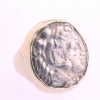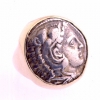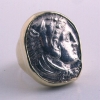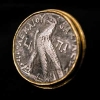|
Ancient Jewelry
|
|
 |
|
 |
|

Price :
$3600.00
Origin: Israel
Circa: 336 BC to 323 BC
Collection: Coin Jewelry
Style: Greek
Medium: Silver-Gold
Few individuals in history have been the subject of such enduring More »
Origin: Israel
Circa: 336 BC to 323 BC
Collection: Coin Jewelry
Style: Greek
Medium: Silver-Gold
Few individuals in history have been the subject of such enduring fascination as Alexander the Great. The son of Philip II (king of Macedonia) and Olympias, he was brought up in an enlightened court, and as crown prince, educated by the Greek philosopher Aristotle. Early in 334 he led an army of nearly 50,000 men across the Hellespont against the Persians. With the aid of remarkable generals and loyal troops he achieved one astonishing success after another, finally conquering the great Persian empire and becoming the virtual master of the western world. This powerful tetradrachm shows the head of a young Herakles (with whom Alexander identified), c1ad in a lion's skin. On the reverse is the seated Zeus holding an eagle and scepter. The name of the king AËÎÃÃÄÑÃÕ (Alexander) is at right. The posture of Zeus, with his right leg drawn back suggests this coin was minted after Alexander's death. The person who chooses this ring must certainly possess the same qualities as the person for whom it honors-- an indomitable will, bold character, and an unconquered spirit. - (FJ.6102) « Less
|
|
Ancient Jewelry
|
|
|
|
|
| Vendor Details |
Close |
| Contact Info : |
| Barakat Gallery |
| 405 North Rodeo Drive |
| Beverly Hills |
| California-90210 |
| USA |
| Email : barakat@barakatgallery.com |
| Phone : 310.859.8408 |
|
|
|
|
|
|

Price :
$3600.00
Origin: Israel
Circa: 336 BC to 323 BC
Collection: Coin Jewelry
Style: Greek
Medium: Silver, Gold
Few individuals in history have been the subject of such enduring More »
Origin: Israel
Circa: 336 BC to 323 BC
Collection: Coin Jewelry
Style: Greek
Medium: Silver, Gold
Few individuals in history have been the subject of such enduring fascination as Alexander the Great. The son of Philip II (king of Macedonia) and Olympias, he was brought up in an enlightened court, and as crown prince, educated by the Greek philosopher Aristotle. Early in 334 he led an army of nearly 50,000 men across the Hellespont against the Persians. With the aid of remarkable generals and loyal troops he achieved one astonishing success after another, finally conquering the great Persian empire and becoming the virtual master of the western world. This powerful tetradrachm shows the head of a young Herakles (with whom Alexander identified), c1ad in a lion's skin. On the reverse is the seated Zeus holding an eagle and scepter. The name of the king AËÎÃÃÄÑÃÕ (Alexander) is at right. The posture of Zeus, with his right leg drawn back suggests this coin was minted after Alexander's death. The person who chooses this ring must certainly possess the same qualities as the person for whom it honors-- an indomitable will, bold character, and an unconquered spirit. - (FJ.6103) « Less
|
|
Ancient Jewelry
|
|
|
|
|
| Vendor Details |
Close |
| Contact Info : |
| Barakat Gallery |
| 405 North Rodeo Drive |
| Beverly Hills |
| California-90210 |
| USA |
| Email : barakat@barakatgallery.com |
| Phone : 310.859.8408 |
|
|
|
|
|
|

Price :
$3600.00
Origin: Israel
Circa: 336 BC to 323 BC
Collection: Coin Jewelry
Style: Greek
Medium: Silver and Gold
Few individuals in history have been the subject of such enduring More »
Origin: Israel
Circa: 336 BC to 323 BC
Collection: Coin Jewelry
Style: Greek
Medium: Silver and Gold
Few individuals in history have been the subject of such enduring fascination as Alexander the Great. The son of Philip II (king of Macedonia) and Olympias, he was brought up in an enlightened court, and as crown prince, educated by the Greek philosopher Aristotle. Early in 334 he led an army of nearly 50,000 men across the Hellespont against the Persians. With the aid of remarkable generals and loyal troops he achieved one astonishing success after another, finally conquering the great Persian empire and becoming the virtual master of the western world. This powerful tetradrachm shows the head of a young Herakles (with whom Alexander identified), c1ad in a lion's skin. On the reverse is the seated Zeus holding an eagle and scepter. The name of the king AËÎÃÃÄÑÃÕ (Alexander) is at right. The posture of Zeus, with his right leg drawn back suggests this coin was minted after Alexander's death. The person who chooses this ring must certainly possess the same qualities as the person for whom it honors-- an indomitable will, bold character, and an unconquered spirit. - (FJ.6109) « Less
|
|
Ancient Jewelry
|
|
|
|
|
| Vendor Details |
Close |
| Contact Info : |
| Barakat Gallery |
| 405 North Rodeo Drive |
| Beverly Hills |
| California-90210 |
| USA |
| Email : barakat@barakatgallery.com |
| Phone : 310.859.8408 |
|
|
|
|
|
|

Price :
$4900.00
Origin: Asia Minor
Circa: 4 BC to 3 BC
Collection: Coin Jewelry
Style: Greek Coin Rings
Medium: Silver, Gold
The island nation of Rhodes was an immensely successful More »
Origin: Asia Minor
Circa: 4 BC to 3 BC
Collection: Coin Jewelry
Style: Greek Coin Rings
Medium: Silver, Gold
The island nation of Rhodes was an immensely successful commercial power of the Aegean. They strategically sided with Athens but, when in jeopardy, negotiated favorable surrenders to Sparta, Alexander the Great, and Demetrios Poliorketes, allowing them to sustain at least some degree of independence based on neutrality. Rhodes was named for the rose, depicted on the reverse of this coin. A portrait of Helios, the sun god, wearing a crown of rays graces the obverse. This image was based upon the head of the great statue of Helios, better known as the Colossus of Rhodes, one of the Seven Wonders of the Ancient World. The Colossus memorialized the war with Demetrios Poliorketes. He unsuccessfully attacked the city for over a year, around 305-304 B.C. Eventually, a settlement was negotiated and Poliorketes abandoned his siege towers constructed from valuable timbers that the Rhodeans in turn sold off for shipbuilding. The proceeds from this sale were invested in the huge (105 ft.) bronze statue of Helios standing at the entrance of the harbor. While the famous statue served as a reminder of the city's fortitude during the siege and became a tourist attraction, it only stood until 227 B.C. when it was toppled by an earthquake.The splendor of the precious metals is allowed to shine in this ring. The natural hues of the silver and the gold perfectly complement each other. In this ring, the present and the past combine. The classic form of the modern ring, engraved on the sides with a decorative motif, enhances and elegantly displays the timeless majesty of this ancient coin. To wear this ring is to reconnect with the past, all the while demonstrating a style that is contemporary and yet timeless. - (FJ.6625) « Less
|
|
Ancient Jewelry
|
|
|
|
|
| Vendor Details |
Close |
| Contact Info : |
| Barakat Gallery |
| 405 North Rodeo Drive |
| Beverly Hills |
| California-90210 |
| USA |
| Email : barakat@barakatgallery.com |
| Phone : 310.859.8408 |
|
|
|
|
|
|

Price :
$6300.00
Origin: Egypt
Circa: 85 BC to 51 BC
Collection: Jewelry
Style: Ptolemaic Coin Ring
Medium: Silver and Gold
Additional Information: This Genuine Ancient Coin Has Been Set More »
Origin: Egypt
Circa: 85 BC to 51 BC
Collection: Jewelry
Style: Ptolemaic Coin Ring
Medium: Silver and Gold
Additional Information: This Genuine Ancient Coin Has Been Set in a Modern 24 Karat Gold Ring
Following the death of Alexander the Great, his empire was divided between his three generals, each of whom set up their own kingdoms. One of them, Ptolemy, took Egypt as his share and made Alexandria his capital. Ruling as Ptolemy I Soter, he established the last dynasty to rule Egypt with the title of Pharaoh. For the next two and a half centuries, the Ptolemaic Dynasty of Greeks controlled Egypt, mingling Hellenic traditions with the mighty legacy of the Pharaohs. Ptolemy XII Neos Dionysos was the illegitimate son of Lathyros (Ptolemy IX Soter II) and fled to the court of Mithradates VI of Pontus following the death of his father. Having deposed Ptolemy XI Alexander II, the people of Egypt remembered the illegitimate son of their previous ruler and he ascended the throne as Ptolemy XII, although he referred to himself as “Theos Philopator Philadelphos Neos Dionysos.†He was married to his sister, Cleopatra V Tryphaena but is perhaps best known as the father of the celebrated, ambitious Cleopatra VII, destined to be the last of the Ptolemies.The glories of antiquity shine again with renewed brilliance and luster. The legend surrounding Ptolemy XII, and his notorious daughter Cleopatra, becomes reality when this ring is worn. The past literally comes alive. This ancient coin is a shining vestige of the ancient glory of Egypt under Greek rule passed from the hands of civilization to civilization, from generation to generation. However, unlike much of antiquity, it is not a relic of the past displayed behind glass in a museum; but mounted in this ring, the coin is a stunning centerpiece appreciated for its age as much as its beauty and superior craftsmanship. - (FJ.7133) « Less
|
|
Ancient Jewelry
|
|
|
|
|
| Vendor Details |
Close |
| Contact Info : |
| Barakat Gallery |
| 405 North Rodeo Drive |
| Beverly Hills |
| California-90210 |
| USA |
| Email : barakat@barakatgallery.com |
| Phone : 310.859.8408 |
|
|
|
|
|
|

Price :
$5600.00
Origin: Egypt
Circa: 85 BC to 51 BC
Collection: Coin Jewelry
Style: Ptolemaic Coin Ring
Medium: Silver and Gold
Additional Information: This Genuine Ancient Coin Has More »
Origin: Egypt
Circa: 85 BC to 51 BC
Collection: Coin Jewelry
Style: Ptolemaic Coin Ring
Medium: Silver and Gold
Additional Information: This Genuine Ancient Coin Has Been Set in a Modern 18 Karat Gold Ring
Following the death of Alexander the Great, his empire was divided between his three generals, each of whom set up their own kingdoms. One of them, Ptolemy, took Egypt as his share and made Alexandria his capital. Ruling as Ptolemy I Soter, he established the last dynasty to rule Egypt with the title of Pharaoh. For the next two and a half centuries, the Ptolemaic Dynasty of Greeks controlled Egypt, mingling Hellenic traditions with the mighty legacy of the Pharaohs. Ptolemy XII Neos Dionysos was the illegitimate son of Lathyros (Ptolemy IX Soter II) and fled to the court of Mithradates VI of Pontus following the death of his father. Having deposed Ptolemy XI Alexander II, the people of Egypt remembered the illegitimate son of their previous ruler and he ascended the throne as Ptolemy XII, although he referred to himself as “Theos Philopator Philadelphos Neos Dionysos.†He was married to his sister, Cleopatra V Tryphaena but is perhaps best known as the father of the celebrated, ambitious Cleopatra VII, destined to be the last of the Ptolemies.The glories of antiquity shine again with renewed brilliance and luster. The legend surrounding Ptolemy XII, and his notorious daughter Cleopatra, becomes reality when this ring is worn. The past literally comes alive. This ancient coin is a shining vestige of the ancient glory of Egypt under Greek rule passed from the hands of civilization to civilization, from generation to generation. However, unlike much of antiquity, it is not a relic of the past displayed behind glass in a museum; but mounted in this ring, the coin is a stunning centerpiece appreciated for its age as much as its beauty and superior craftsmanship. - (FJ.7139) « Less
|
|
Ancient Jewelry
|
|
|
|
|
| Vendor Details |
Close |
| Contact Info : |
| Barakat Gallery |
| 405 North Rodeo Drive |
| Beverly Hills |
| California-90210 |
| USA |
| Email : barakat@barakatgallery.com |
| Phone : 310.859.8408 |
|
|
|
|
|
|

Price :
$3300.00
Origin: Mediterranean
Circa: 336 BC to 323 BC
Collection: Coin Jewelry
Style: Macedonian
Medium: Silver and Gold
More than money, coins are symbols of the state that More »
Origin: Mediterranean
Circa: 336 BC to 323 BC
Collection: Coin Jewelry
Style: Macedonian
Medium: Silver and Gold
More than money, coins are symbols of the state that struck them. Currency represents a specific time and place, whether products of the age we live in today or an artifact of a long forgotten empire. Worth a month’s pay, a silver coin like this would have rewarded the bravery and fortitude of the officers serving under one of history’s most celebrated generals, Alexander the Great. Son to King Phillip II of Macedon, tutored in his youth by Aristotle, Alexander conquered one of the largest empires the world has ever known. Marching from Egypt, through Asia Minor, and into the heart of central Asia, Alexander lead a swift and successful military campaign that defeated the potent Persians and stretched the edges of Hellenic civilization into new lands. While his vast kingdom dissolved after his death, the carefully cultivated legend of Alexander will continue to live on not only in our history books and museums, but also in artifacts like this coin: concrete remnants of ancient kingdoms passed from the hands of civilization to civilization, from generation to generation.The glories of antiquity shine again with renewed brilliance and luster. Alexander is among the most celebrated and enduring figures of history. The legend surrounding this great figure becomes reality when wearing this ring. The past literally comes alive. This ancient coin is not a relic of the past displayed behind glass in a museum; but mounted in this ring, the coin is a stunning centerpiece appreciated for its age as much as its beauty and superior craftsmanship. - (FJ.7120) « Less
|
|
Ancient Jewelry
|
|
|
|
|
| Vendor Details |
Close |
| Contact Info : |
| Barakat Gallery |
| 405 North Rodeo Drive |
| Beverly Hills |
| California-90210 |
| USA |
| Email : barakat@barakatgallery.com |
| Phone : 310.859.8408 |
|
|
|
|
|
|

Price :
$2800.00
Origin: Mediterranean
Circa: 336 BC to 323 BC
Collection: Coin Jewelry
Style: Macedonian
Medium: Silver and Gold
Condition: Extra Fine
Additional Information: Size More »
Origin: Mediterranean
Circa: 336 BC to 323 BC
Collection: Coin Jewelry
Style: Macedonian
Medium: Silver and Gold
Condition: Extra Fine
Additional Information: Size 8.5
Alexander the Great (Greek: ÎœÎγας ἈλÎξανδÏος,[1] Megas Alexandros; July 20 356 BC–June 10, 323 BC), also known as Alexander III, king of Macedon (336–323 BC), was one of the most successful military commanders in history. The name 'Alexander' derives from the Greek words "alexo" (αλÎξω, refuge, defense, protection) and "aner" (ανήÏ, man). Before his death, he conquered most of the world known to the ancient Greeks. Alexander is also known in the Zoroastrian Middle Persian work Arda Wiraz NÄmag as "the accursed Alexander" due to his conquest of the Persian Empire and the destruction of its capital Persepolis. He is known as Eskandar-e Maqduni (Alexander of Macedonia) in Persian, Al-Iskander Al-Makadoni (Alexander of Macedonia) in Arabic, Alexander Mokdon in Hebrew, and Tre-Qarnayia in Aramaic (the two-horned one, apparently due to an image on coins minted during his rule that seemingly depicted him with the two ram's horns of the Egyptian god Ammon), al-Iskandar al-Akbar الاسكندر الاكبر in Arabic, Sikandar-e-azam in Urdu, Skandar in Pashto. Sikandar, his name in Urdu and Hindi, is also a term used as a synonym for "expert" or "extremely skilled". Following the unification of the multiple city- states of ancient Greece under the rule of his father, Philip II of Macedon (a labour Alexander had to repeat twice because the southern Greeks rebelled after Philip's death), Alexander conquered the Persian Empire, including Anatolia, Syria, Phoenicia, Judea, Gaza, Egypt, Bactria and Mesopotamia and extended the boundaries of his own empire as far as the Punjab. Before his death, Alexander had already made plans to also turn west and conquer Europe. He also wanted to continue his march eastwards in order to find the end of the world, since his boyhood tutor Aristotle told him tales about where the land ends and the Great Outer Sea begins. Alexander integrated foreigners into his army, leading some scholars to credit him with a "policy of fusion." He encouraged marriage between his army and foreigners, and practiced it himself. After twelve years of constant military campaigning, Alexander died, possibly of malaria, West Nile virus, typhoid, viral encephalitis, or the consequences of heavy drinking. His conquests ushered in centuries of Greek settlement and cultural influence over distant areas, a period known as the Hellenistic Age, a combination of Greek and Middle Eastern culture. Alexander himself lived on in the history and myth of both Greek and non-Greek cultures. After his death (and even during his life) his exploits inspired a literary tradition in which he appears as a legendary hero in the tradition of Achilles. More than money, coins are symbols of the state that struck them. Currency represents a specific time and place, whether products of the age we live in today or an artifact of a long forgotten empire. Worth a week’s pay, a silver coin like this would have rewarded the bravery and fortitude of the officers serving under one of history’s most celebrated generals, Alexander the Great. Son to King Phillip II of Macedon, tutored in his youth by Aristotle, Alexander conquered one of the largest empires the world has ever known. Marching from Egypt, through Asia Minor, and into the heart of central Asia, Alexander lead a swift and successful military campaign that defeated the potent Persians and stretched the edges of Hellenic civilization into new lands. While his vast kingdom dissolved after his death, the carefully cultivated legend of Alexander will continue to live on not only in our history books and museums, but also in artifacts like this coin: concrete remnants of ancient kingdoms passed from the hands of civilization to civilization, from generation to generation.The glories of antiquity shine again with renewed brilliance and luster. Alexander is among the most celebrated and enduring figures of history. The legend surrounding this great figure becomes reality when wearing this ring. The past literally comes alive. This ancient coin is not a relic of the past displayed behind glass in a museum; but mounted in this ring, the coin is a stunning centerpiece appreciated for its age as much as its beauty and superior craftsmanship. - (FJ.7141A) « Less
|
|
Ancient Jewelry
|
|
|
|
|
| Vendor Details |
Close |
| Contact Info : |
| Barakat Gallery |
| 405 North Rodeo Drive |
| Beverly Hills |
| California-90210 |
| USA |
| Email : barakat@barakatgallery.com |
| Phone : 310.859.8408 |
|
|
|
|
|
|

Price :
$3700.00
Origin: Mediterranean
Circa: 336 BC to 323 BC
Collection: Jewelry
Style: Macedonian Coin Ring
Medium: Silver and Gold
More than money, coins are symbols of the state More »
Origin: Mediterranean
Circa: 336 BC to 323 BC
Collection: Jewelry
Style: Macedonian Coin Ring
Medium: Silver and Gold
More than money, coins are symbols of the state that struck them. Currency represents a specific time and place, whether products of the age we live in today or an artifact of a long forgotten empire. Worth a week’s pay, a silver coin like this would have rewarded the bravery and fortitude of the officers serving under one of history’s most celebrated generals, Alexander the Great. Son to King Phillip II of Macedon, tutored in his youth by Aristotle, Alexander conquered one of the largest empires the world has ever known. Marching from Egypt, through Asia Minor, and into the heart of central Asia, Alexander lead a swift and successful military campaign that defeated the potent Persians and stretched the edges of Hellenic civilization into new lands. While his vast kingdom dissolved after his death, the carefully cultivated legend of Alexander will continue to live on not only in our history books and museums, but also in artifacts like this coin: concrete remnants of ancient kingdoms passed from the hands of civilization to civilization, from generation to generation.The glories of antiquity shine again with renewed brilliance and luster. Alexander is among the most celebrated and enduring figures of history. The legend surrounding this great figure becomes reality when wearing this ring. The past literally comes alive. This ancient coin is not a relic of the past displayed behind glass in a museum; but mounted in this ring, the coin is a stunning centerpiece appreciated for its age as much as its beauty and superior craftsmanship. - (FJ.7144) « Less
|
|
Ancient Jewelry
|
|
|
|
|
| Vendor Details |
Close |
| Contact Info : |
| Barakat Gallery |
| 405 North Rodeo Drive |
| Beverly Hills |
| California-90210 |
| USA |
| Email : barakat@barakatgallery.com |
| Phone : 310.859.8408 |
|
|
|
|
|
|

Price :
$3700.00
Origin: Mediterranean
Circa: 336 BC to 323 BC
Collection: Jewelry
Style: Greek Coin Ring
Medium: Silver and Gold
More than money, coins are symbols of the state that More »
Origin: Mediterranean
Circa: 336 BC to 323 BC
Collection: Jewelry
Style: Greek Coin Ring
Medium: Silver and Gold
More than money, coins are symbols of the state that struck them. Currency represents a specific time and place, whether products of the age we live in today or an artifact of a long forgotten empire. The image of one of history’s most celebrated generals, Alexander the Great, graces the front of this coin. Son to King Phillip II of Macedon, tutored in his youth by Aristotle, Alexander conquered one of the largest kingdoms the world has ever known. Marching from Egypt, through Asia Minor, and into the heart of central Asia, Alexander lead a swift and successful military campaign that defeated the potent Persians and stretched the edges of Hellenic civilization into new lands. While his vast kingdom dissolved after his death, the carefully cultivated legend of Alexander will continue to live on not only in our history books and museums, but also in artifacts like this coin: concrete remnants of ancient empires passed from the hands of civilization to civilization, from generation to generation.The glories of antiquity shine again with renewed brilliance and luster. Alexander is among the most celebrated and enduring figures of history. The legend surrounding this great figure becomes reality when wearing this ring. The past literally comes alive. This ancient coin is not a relic of the past displayed behind glass in a museum; but mounted in this ring, the coin is a stunning centerpiece appreciated for its age as much as its beauty and masterful craftsmanship. - (FJ.7138b) « Less
|
|
Ancient Jewelry
|
|
|
|
|
| Vendor Details |
Close |
| Contact Info : |
| Barakat Gallery |
| 405 North Rodeo Drive |
| Beverly Hills |
| California-90210 |
| USA |
| Email : barakat@barakatgallery.com |
| Phone : 310.859.8408 |
|
|
|
|
|
|
|
|

|


